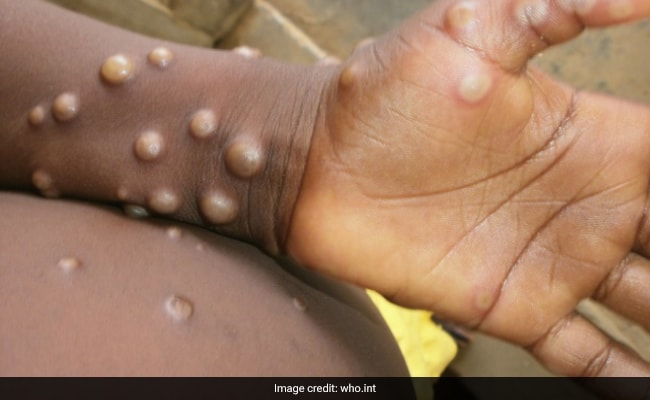Monkeypox is a rare viral zoonotic infectious disease (i.e. an infection transmitted from animals to humans) that occurs sporadically, primarily in remote villages of Central and West Africa, near tropical rainforests. It is caused by the monkeypox virus which belongs to the Orthopoxvirus genus in the family Poxviridae. The Orthopoxvirus genus also includes variola virus (the cause of smallpox), vaccinia virus (used in the vaccine for smallpox eradication), and cowpox virus (used in earlier smallpox vaccines). Following the eradication of smallpox, monkeypox virus has emerged as the most important Orthopoxvirus.
Monkeypox was discovered in 1958 when two outbreaks of a pox-like disease occurred in colonies of monkeys kept for research, hence the name monkeypox. The first human case was recorded in 1970 in the Democratic Republic of Congo during a period of intensified efforts to eliminate smallpox. Since then, monkeypox has been reported in humans in other central and western African countries including Nigeria, Cameroon, Gabon, Côte d’Ivoire, Liberia, Central African Republic, Congo, South Sudan and Sierra Leone. A 2003 outbreak in the United States was the first time monkeypox infections in humans were documented outside Africa. Other non- African countries such as the UK, Israel and SIngapore have also reported imported monkeypox cases from Africa. In May 2022, several countries in Europe and North America including Italy, France, Germany, Sweden, Spain, Portugal, Australia, Canada and Belgium have reported confirmed cases of Monkeypox with no direct epidemiological linkage to Africa.
Case fatality in outbreaks has been between 1% and 10%, with most deaths occurring in younger age groups and immunocompromised patients. There are two distinct types, Congo Basin and West African clades, with the former being more virulent.
Until the recent outbreak of 2017, the last time that cases of monkeypox were reported in Nigeria was in the 1970s. The 2017 Nigerian outbreak is the largest documented outbreak of the West African clade to date.
Transmission
The exact reservoir of monkeypox is still unknown although African rodents are suspected to play a part in transmission. The virus can spread both from animal to human and from human to human with transmission occurring when a person comes into contact with the virus from an infected animal, human, or materials contaminated with the virus such as bedclothes. The virus enters the body through broken skin (even if not visible), the respiratory tract, or the mucous membranes of the eyes, nose, or mouth.
Animal-to-human transmission may occur by direct contact with the blood, body fluids, the skin or mucosal lesions of infected animals (e.g. monkeys, squirrels and rodents). This can happen through a bite, scratch, handling , eating of inadequately cooked infected bushmeat. Limited human-to-human transmission is thought to occur primarily through prolonged face-to-face contact via large respiratory droplets. It can also result from direct contact with the body fluids or skin lesions of an infected person, or objects they have contaminated such as clothing or bed linen. As such, household members or healthcare workers are at greater risk of infection.
Symptoms
The incubation period of monkeypox is usually between 6 to 16 days but can range from 5 to 21 days. The clinical manifestation of the disease has two phases, with an initial invasive period in the first 5 days, where the main symptoms are fever, lymphadenopathy (swelling of lymph nodes), back pain, intense headache, myalgia (muscle ache) and severe asthenia (lack of energy). A maculopapular rash (skin lesions with a flat bases) appears 1-3 days after the onset of fever, developing into small fluid-filled blisters (vesicles), which become pus-filled (pustules) and then crust over in about 10 days.
Complete resolution takes up to three weeks. Nearly all patients have face lesions, three quarters have lesions on the palms of their hands and soles of their feet, and 30% have genital involvement. The eyes are involved in most cases, 20% have lesions on the eyelid, with some on the cornea. There are oral mucosa lesions in 70% of cases. Skin lesions can vary widely from a few to up to many thousands, and the lymph node swelling can precede the rash unlike in other Orthopoxvirus infections.
Monkeypox is usually self-limiting, with symptoms lasting between 2 and 3 weeks. Severe cases occur more commonly among children, who also have greater mortality – the case fatality has ranged from 1% to 10%, higher in Congo Basin cases.
Diagnosis/Testing
Polymerase chain reaction (PCR) of lesions is the mainstay of monkeypox diagnosis. Swabs and scabs from skin lesions are sent to the designated reference laboratory in dry containers. Serum samples can also be taken, however, these often yield negative results due to the transient viraemia.
Antibody (ELISA) tests can show past exposure to Orthopoxvirus infections, and certain reference facilities can perform virus isolation by cell culture in high containment. In order to interpret test results, it is critical that patient information is provided with the specimens including:
a) Approximate date of onset of fever
b) Date of onset of rash
c) Date of specimen collection
d) Current status of the individual (stage of rash)
e) Age.
CASE DEFINITION
Case definitions developed by the Nigeria Centre for Disease Control (NCDC) in the wake of the 2017 outbreak are as follows with reporting to be done via the Integrated Disease Surveillance and Response (IDSR) reporting platform.
Suspected case:
– Any person presenting with a history of sudden onset of fever, followed by a vesiculopustular rash occurring mostly on the face, palms and soles of feet.
Confirmed Case:
– Any suspected case with laboratory confirmation (Positive IgM Antibody, PCR or Virus isolation).
Contact:
– Any person who has no symptoms but who has been in physical contact with or exposed to the body fluids of a confirmed case in the last three weeks (i.e. skin secretions, oral secretions, pre-mastication of food, urine, stools, vomiting, blood, sexual contact)
Treatment
There are no specific treatments available for monkeypox infection, although various novel antivirals have in-vitro and animal data supportive of effect such as Brincindofovir and Tecovirimat. Vaccination against smallpox has been proven to be 85% effective in preventing monkeypox but is no longer routinely available following global smallpox eradication. Post exposure vaccination may help prevent the disease or reduce its severity. Prior smallpox vaccination will likely result in having a milder disease course. Screening and management of co-morbidities and all other secondary infections should be carried out.
INFECTION PREVENTION AND CONTROL (IPC)
Measures that can be taken to prevent infection with monkeypox virus include:
– Avoiding contact with animals that could harbor the virus including sick or dead animals in areas where monkeypox cases have occurred.
– Avoiding contact with any material that has been in contact with a sick animal.
– Isolating potentially infected animals from other animals.
– Quarantine of any animals that might have come into contact with an infected animal, handling them with standard precautions and observing for monkeypox symptoms for 30 days and washing with soap and water after contact with infected animals.
– Thoroughly cooking all animal products before eating.
– Isolation of infected patients, including use of personal protective equipment and implementation of standard infection control precautions by health workers.
– Regular hand washing after caring for or visiting sick people.
– Public health education on preventive measures.
Source: Nigeria Centre for Disease Control











Leave a comment